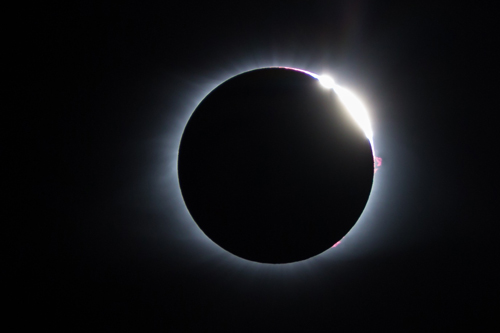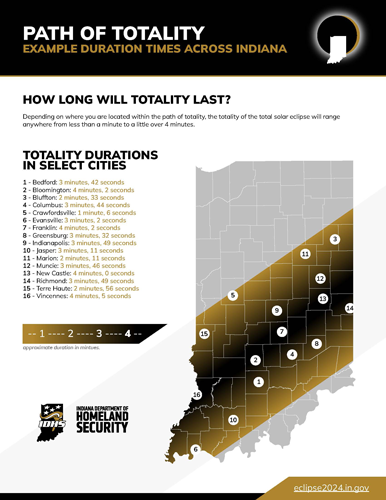Select the topics below to find answers to common questions about the total solar eclipse.
- When will the eclipse occur, and for how long?
All areas of Indiana will see at least a partial eclipse on April 8, 2024. The eclipse will begin at approximately 1:45 p.m. Eastern and end at about 4:30 p.m. Eastern. However, only places within the 115-mile-wide path of totality will see a total solar eclipse. Totality will begin at roughly 3 p.m. Eastern in the southwestern part of the state, and regardless of where you are in Indiana, totality will be finished everywhere in the state by 3:15 p.m. Eastern. Note: Portions of southwestern Indiana are in the Central time zone, so totality will be at approximately 2 p.m. local time (Central time) in those areas.
- Partial eclipse: Approximately 1:45 to 3 p.m. Eastern
- Total solar eclipse: Approximately 3 to 3:15 p.m. Eastern (totality is a maximum of about 4 minutes, duration depends on location)
- Partial eclipse: Approximately 3:15 to 4:30 p.m. Eastern
The time of totality varies by location. It will last about 30 seconds in some places, but most places along the centerline will have a totality duration between 3.5 and 4 minutes.
- What does the path of totality mean?
The path of totality is the area where the moon will completely cover the sun. This plunges the sky from daylight to twilight temporarily. Although the sky will darken in areas that will see a 99% solar eclipse or less, the experience in totality will be much different.
According to the Planetary Society, only 43 million people (0.5% of the world population) live in the path of totality for the April 2024 total solar eclipse.
- How much will daylight change?
In the path of totality, the moon covers 100% of the sun. Even if it is a cloudy day, the landscape will darken dramatically during totality. The sky will be 10,000 times darker in areas of totality than areas where just 1% of the sun is visible (99% partial eclipse), and some bright planets and stars may become visible.
Areas outside the path of totality will see the sky darken somewhat, depending on how much the sun is blocked in that location.
- How much will the temperature change?
Temperatures may drop as much as 10 degrees Fahrenheit.
- What are the stages of the total solar eclipse?

Baily's beads and diamond ring effect occur near totality.
Baily's beads and diamond ring effect occur near totality.- Partial eclipse: As the moon comes between the earth and sun, the sun appears to have a crescent shape. This will gradually become smaller. This stage is the longest, and viewers must wear safety glasses to avoid eye injury.
- Shadow bands: Thin wavy lines of alternating light and darkness appear in the few seconds before totality occurs. They move in parallel and can be seen on plain-colored surfaces immediately before and after totality.
- Baily's beads: An arc of bright spots surrounding the moon will occur just as totality begins and ends. The bead effect is when small beads of sunlight shine across irregularities on the surface of the moon, such as mountains and valleys.
- Diamond ring: Immediately before and after totality, a bright spot of sunlight called the "diamond" remains visible.
- Totality: During totality, viewers can see the solar corona and solar prominences.
The stages of the eclipse reverse after totality occurs.
- What is the difference between a total solar eclipse and an annular eclipse?
A total solar eclipse is when the moon passes between the sun and earth, completely blocking the sun. A total solar eclipse is the only kind of solar eclipse when viewers can remove their eclipse glasses for a brief time while the moon is completely obscuring the sun.
An annular solar eclipse is when the moon passes between the sun and earth when it is at or near its farthest point from earth. Because the moon is farther away from earth, it does not completely cover the sun and appears as a dark disk on top of a larger, bright disk. This looks like there is a ring around the moon. During annular solar eclipses, it is not safe to look directly at the sun without specialized eye protection.
A partial solar eclipse is when the moon only partially covers the disk of the sun. Partial solar eclipses happen during total solar eclipses in areas outside of the path of totality and also during annular solar eclipses in areas surrounding the path of annularity.
- How rare are total solar eclipses?
On average, there are about two or three solar eclipses each year somewhere on earth. There are about two total solar eclipses every three years.
A total solar eclipse occurs on a given spot on the planet only once about every 375 years. Portions of Indiana will not be in the path of totality for a total solar eclipse again until 2099.
The most recent total solar eclipses viewable from the contiguous United States were in February 1979, August 2017 and October 2023.
- What makes a total solar eclipse special?
Earth is the only planet in our solar system with a moon that is the right size and distance away. Because the sun is about 400 times larger than the moon, but also about 400 times farther away, the two can appear to be the same size in the sky.
The most special aspects of a total solar eclipse only occur within the path of totality, which will only be about 115 miles wide for the 2024 eclipse. In those locations that are within that path, viewers will get to see things they can see at no other time.
During totality, the sky will appear somewhat like a 360-degree sunset. Some stars and planets may come into view. The temperature will cool. Shadow bands of light, sometimes called shadow snakes, will appear on plain-colored surfaces.
The pinnacle of the eclipse for many people is to see the sun’s outer atmosphere, called the corona. It is usually too dim to see because the sun is so bright, but it becomes visible only when the sun is completely covered by the moon. Total solar eclipses are the only type of solar eclipse when viewers can remove eclipse glasses and safely look toward the sun, during the time of totality.
- Where can I see the eclipse?

Marion will experience 2+ minutes of totality.
Marion (Grant County) will experience 2+ minutes of totality.All areas of Indiana will see at least a partial eclipse on April 8, 2024. However, only places within the 115-mile-wide path of totality will see a total solar eclipse.
Places to View the Eclipse
Note: Double-check that the location you are going to will be within the path of totality.
- What if it is cloudy?
Credit: Nebraska Public MediaClear skies are the ideal conditions for the total solar eclipse, but even if it is cloudy, the total solar eclipse will be a memorable experience. The sky will still darken considerably within the path of totality. In fact, it may be even more dark and more night-like if it is cloudy. Viewers of clouded-out eclipses have noted remarkable color changes in the sky and seeing the moon's shadow move. Perhaps, clouds will obscure the sun but leave other areas of the sky clear. In these situations, stars may become visible.
Cloudy conditions can prevent you from witnessing the most special parts of the eclipse, such as the solar corona and solar prominences. However, if the forecast calls for cloudy weather, keep in mind that conditions may change, especially if it is a partly cloudy day. The common refrain among Hoosiers about Indiana weather is "If you don't like the weather, just wait five minutes." A break in the cloud cover may still allow you a view of the sun's corona.
Regardless of the weather, go outside at the time of totality to appreciate this once-in-a-lifetime event. You will still experience being in the shadow of the moon.
Check the Weather
National Weather Service (Indianapolis) forecast
For historical viewability averages based on normal weather conditions, visit the National Oceanic and Atmospheric Administration (NOAA) Viewability Interactive Map.
If Plans Change
Expect traveling on the day of the eclipse to be difficult due to heavy traffic. If planning to move to an area with expected better weather conditions, make sure you check the Indiana Department of Transportation's TrafficWise website or app for current travel conditions on major roadways.
Watch a Livestream
If you are unable to make it to the path of totality or weather conditions prevent you from experiencing it outside, you can watch the eclipse via livestreaming.
More FAQs and Resources
- For FAQs specifically about watching the eclipse from an Indiana DNR property, go to the DNR's 2024 Eclipse FAQs page.
- For FAQs about eclipses in general, visit NASA's FAQs pages about the 2024 total solar eclipse and 2017 total solar eclipse.
- For educational resources, visit the Educator Resources page.
- For additional resources, visit the Public Resources page.
